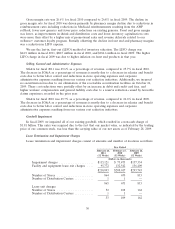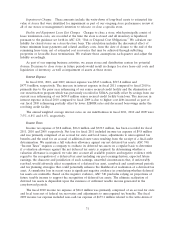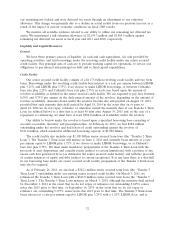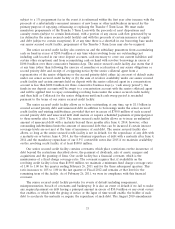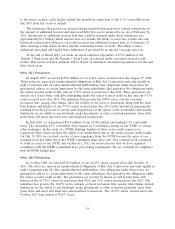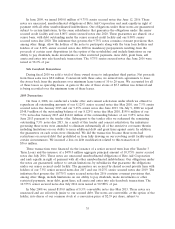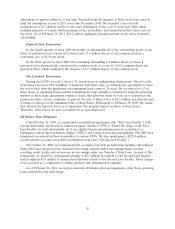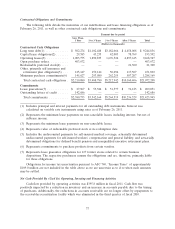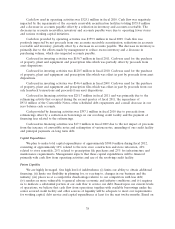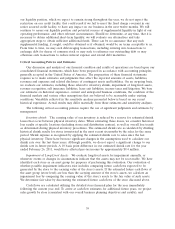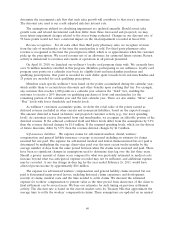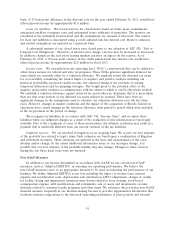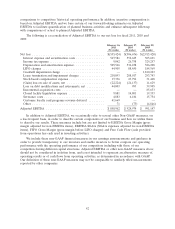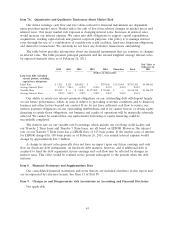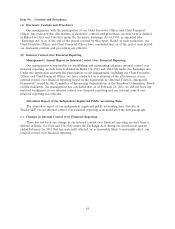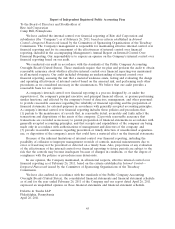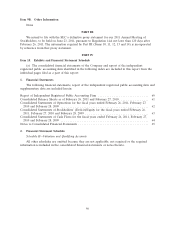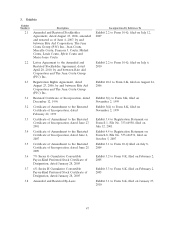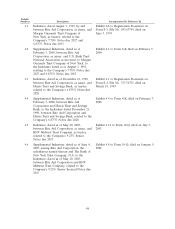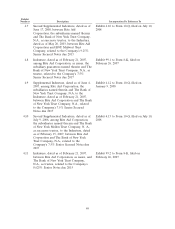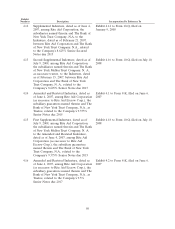Rite Aid 2011 Annual Report Download - page 40
Download and view the complete annual report
Please find page 40 of the 2011 Rite Aid annual report below. You can navigate through the pages in the report by either clicking on the pages listed below, or by using the keyword search tool below to find specific information within the annual report.determine the incremental cash flow that such sales growth will contribute to that store’s operations.
The discount rate used is our credit adjusted risk-free interest rate.
The assumptions utilized in calculating impairment are updated annually. Should actual sales
growth rates and related incremental cash flow differ from those forecasted and projected, we may
incur future impairment charges related to the stores being evaluated. Changes in our discount rate of
50 basis points would not have a material impact on the total impairment recorded in fiscal 2011.
Revenue recognition: For all sales other than third party pharmacy sales, we recognize revenue
from the sale of merchandise at the time the merchandise is sold. For third party pharmacy sales,
revenue is recognized at the time the prescription is filled, which is or approximates when the customer
picks up the prescription. We record revenue net of an allowance for estimated future returns. Return
activity is immaterial to revenues and results of operations in all periods presented.
On April 18, 2010, we launched our wellness+ loyalty card program chain wide. We currently have
over 36 million members enrolled in this program. Members participating in our wellness+ loyalty card
program earn points on a calendar year basis for eligible front end merchandise purchases and
qualifying prescriptions. One point is awarded for each dollar spent towards front end merchandise and
25 points are awarded for each qualifying prescription.
Members reach specific wellness+ tiers based on the points accumulated during the calendar year,
which entitle them to certain future discounts and other benefits upon reaching that tier. For example,
any customer that reaches 1,000 points in a calendar year achieves the ‘‘Gold’’ tier, enabling the
customer to receive a 20% discount on qualifying purchases of front end merchandise for the
remaining portion of the calendar year and the next calendar year. There are also similar ‘‘Silver’’ and
‘‘Plus’’ levels with lower thresholds and benefit levels.
As wellness+ customers accumulate points, we defer the retail value of the points earned as
deferred revenue (included in other current and noncurrent liabilities, based on the expected usage).
The amount deferred is based on historic and projected customer activity (e.g., tier level, spending
level). As customers receive discounted front end merchandise, we recognize an allocable portion of the
deferred revenue. If the achieved combined Gold and Silver levels differ from the assumptions by 5.0%
then the revenue deferral changes by $1.0 million. If the assumed spending levels, which are the drivers
of future discounts, differ by 5.0% then the revenue deferral changes by $1.9 million.
Self-insurance liabilities: We expense claims for self-insured medical, dental, workers’
compensation and general liability insurance coverage as incurred including an estimate for claims
incurred but not paid. The expense for self-insured medical and dental claims incurred but not paid is
determined by multiplying the average claim value paid over the most recent twelve months by the
average number of days from the same period between when the claims were incurred and paid. There
have been no significant changes in assumptions used to determine days lag over the last three years.
Should a greater amount of claims occur compared to what was previously estimated or medical costs
increase beyond what was anticipated, expense recorded may not be sufficient, and additional expense
may be recorded. A one day change in days lag for the year ended February 26, 2011, would have
affected pretax income by approximately $0.6 million.
The expense for self-insured workers’ compensation and general liability claims incurred but not
paid is determined using several factors, including historical claims experience and development,
severity of claims, medical costs and the time needed to settle claims. We discount the estimated
expense for workers’ compensation to present value as the time period from incurrence of the claim to
final settlement can be several years. We base our estimates for such timing on previous settlement
activity. The discount rate is based on the current market rates for Treasury bills that approximate the
average time to settle the workers’ compensation claims. These assumptions are updated on an annual
40


